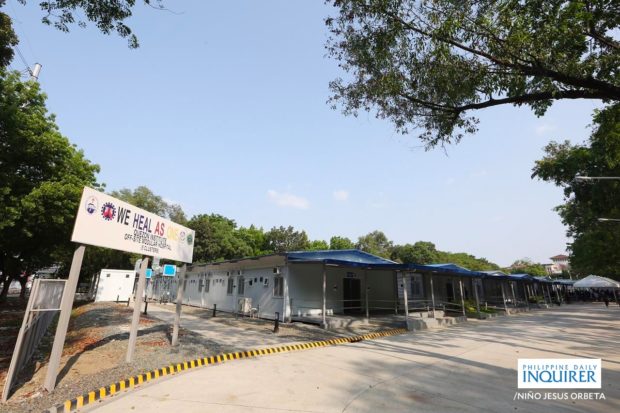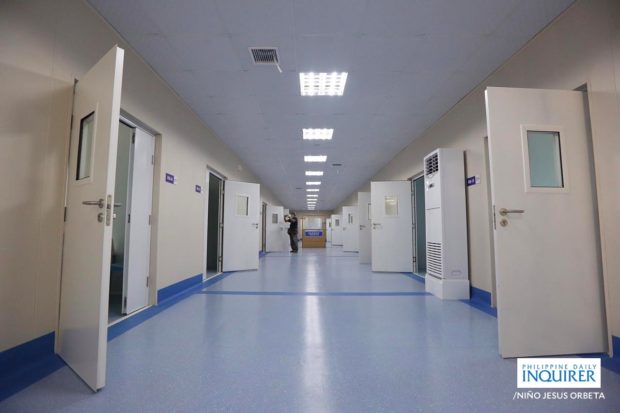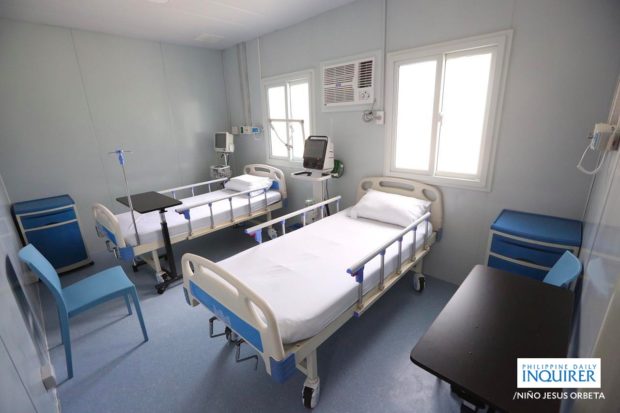New COVID-19 field hospital opens in Quezon City; 5 more soon

READY FOR OCCUPANCY The venerable, more than a century old Quezon Institute (QI), a facility used for the treatment of tuberculosis, a public health concern in an earlier time, finds its sprawling compound repurposed for the fight against the coronavirus pandemic. On Tuesday, a 110-bed facility was inaugurated at QI to help ease hospital congestion and accommodate the more critical COVID-19 cases. —NIÑO JESUS ORBETA
MANILA, Philippines — As private and public hospitals in Metro Manila struggle to accommodate the surge in coronavirus cases, the government hopes to ease the congestion with the opening a new 110-bed field hospital for COVID-19 patients at Quezon Institute (QI) in Quezon City on Tuesday.
More medical facilities that could accommodate as many as 176 more beds are expected to be operational by May, according to the Department of Public Works and Highways (DPWH).
Public Works Secretary Mark Villar on Tuesday said “The modular hospitals we are constructing are for critical care, so, in effect, these are usable as ICU (intensive care unit) rooms.”
Utilization rate
“What is good about these facilities is that they are modular. We used container vans. They can be transferred to other areas if, for example, we no longer need to use them. We can use these for another purpose,” Villar added.
According to the DPWH chief, the QI “modular hospital” was built with high ceilings for better ventilation and living quarters for front-line workers, among other features.
Article continues after this advertisementThe DPWH also plans to complete next month an extension at the QI modular hospital to add 88 more beds.
Article continues after this advertisementThe agency will then build new facilities at the Lung Center of the Philippines, also in Quezon City, also to accommodate 88 more beds, for a total of 176 beds, Villar said.
“Many of what we will build will be in NCR (National Capital Region) because this is where there is a high occupancy rate,” he pointed out.
As of April 5, 79 percent of ICU beds, 72 percent of isolation beds and 60 percent of ward beds in Metro Manila have been used.
Villar said the target was to bring the health-care utilization rate to lower than 60 percent.
Over the past few days, Metro Manila hospitals have been swamped with COVID-19 patients, with long lines forming outside emergency rooms.
Some patients have been referred to hospitals in nearby provinces due to lack of beds.
This has prompted the Philippine College of Physicians to call on the government to repurpose hotels as treatment centers, which the group said would be faster than building modular hospitals.
‘More practical’
Villar said the DPWH was focused on maximizing the use of vacant spaces at public hospitals such as Quezon Institute to build additional facilities for patients.
He said the extensions were built next to the hospitals based on the request of the people who work there.
“Logistically, it would be difficult if the… extension would be too far from the hospital. It would be more practical for the operations [to be] just…beside the hospital,” Villar said.
The government would open more facilities for the COVID-19 patients this week, according to presidential spokesperson Harry Roque.
These will be at Subic Manila Times Colleges, which will have 300 beds; New Clark City, 165 beds; Eva Macapagal Terminal, 200 beds; and Orion Bataan Port Terminal, 100 beds.
Villar said local governments in need of additional field hospitals could get in touch with the DPWH.
Fatality count explained
The Department of Health (DOH) on Tuesday reported 9,373 new cases, which brought the country’s total case count to 812,760.
It noted that the 382 deaths added to the list also on Tuesday were higher than usual, but that this was due to a “technical issue” that resulted in a lower fatality count in the previous week.
The DOH said “a technical issue with the case collection systems resulted in lower reporting of COVID-19 death counts over the past week. The said issue caused incomplete fatality numbers and data to be encoded and as a result, there were 341 deaths prior to April 2021 that went unreported. The number of deaths reported today already includes the said deaths not reported in previous counts.”

FOR CRITICAL CARE The field hospital set up at the grounds of historic Quezon Institute and opened on Tuesday is usable as an ICU (intensive care unit), according to Public Works Secretary Mark Villar. —NIÑO JESUS ORBETA
Tuesday’s death toll raised the total fatalities in the country to 13,817.
The department maintained that the cumulative fatality rate “remains low at 1.7 percent.”
Average daily death count
It also reported that the average daily fatality count in March was 28, compared to 27 in February and 32 in January.
“There has been no reported spike in the number of deaths anywhere in the country,” the DOH said.
At least 313 new patients have recovered, bringing total recoveries to 646,381.
Active cases or those currently sick account for 152,562, or 19 percent of the total cases.
The majority or 97.5 percent of the active cases are mild, 1.1 percent are asymptomatic, 0.5 percent are critical, 0.5 percent are severe and 0.31 percent are moderate.
The DOH said it removed 11 duplicates from the total case count, while 166 cases previously tagged as recoveries were reclassified as deaths following final validation.
Ten laboratories failed to submit their data on time on Tuesday. INQ
